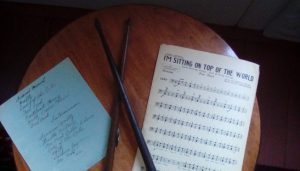 It may surprise you to read (or not, if you’re family) that I have squirrels in my closets. They nest in bins, and hide under papers, books, or textiles when I want to find one, or shout for attention when I don’t. But I like living indoors without wildlife, so these are not the red or gray, bushy-tailed squirrels, but the genealogical kind described by Meaghan E.H. Siekman in her essay “Chasing a Squirrel.” Continue reading ‘Where was the music?’
It may surprise you to read (or not, if you’re family) that I have squirrels in my closets. They nest in bins, and hide under papers, books, or textiles when I want to find one, or shout for attention when I don’t. But I like living indoors without wildlife, so these are not the red or gray, bushy-tailed squirrels, but the genealogical kind described by Meaghan E.H. Siekman in her essay “Chasing a Squirrel.” Continue reading ‘Where was the music?’
All posts by Jan Doerr
Memories of things unknown
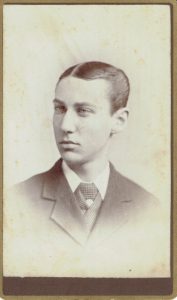
Many family history researchers are hard-pressed to find personal information, photographs, memorabilia, or heirlooms to treasure and preserve. I am not one of them, and yet I seem to have a remarkable supply of “memories of things unknown,” the scraps of someone’s attempt to memorialize a moment or a personality in a manner obvious to the author but obscure to later generations. I have stacks of unmarked photos of unnamed family members, locations, cattle, horses, barn cats, and especially Dalmatian dogs.
My great-grandfather Ambrose Church’s autograph book from his school days at the Oak Grove Seminary in Vassalboro, Maine – a girls’ school founded by the Society of Friends, but open as co-ed to local children – is a case in point. Continue reading Memories of things unknown
Well be gone
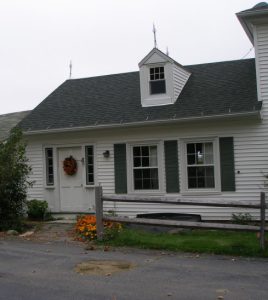
Researching family history takes us to many places: libraries, museums, various genealogical repositories (New England Historic Genealogical Society, of course!), cemeteries, and . . . driveways. An historical archaeological adventure is the sort of research that happened when I wasn’t looking!
The dooryard and then the driveway of my old Asa Williams house had always been hard-packed dirt, until in 1979 my father had the chance to have it paved, making it easier to plow in winter and eliminating the usual signs of mud season. If asphalt improved the look of things, it also covered a multitude of landscaping sins. Continue reading Well be gone
Once in a blue moon
 Everyone who indulges in family history research understands the role that serendipity plays in successfully locating the ancestors we seek. I have recently come to understand what a confluence of serendipity and a blue moon can mean to my research, my focus on family stories, and a brick wall.
Everyone who indulges in family history research understands the role that serendipity plays in successfully locating the ancestors we seek. I have recently come to understand what a confluence of serendipity and a blue moon can mean to my research, my focus on family stories, and a brick wall.
A blue moon occurred on Saturday, 21 May 2016, a day I had arranged a first meeting with a distant Saunders-Cummings cousin to share family stories and data. Her arrival was preceded by an totally unexpected visit by another distant cousin in the same Cummings line. The day was full of family stories and photos. My patient husband managed to endure, but later commented that he had no family stories to tell. (Never a prophet in my own house!) Continue reading Once in a blue moon
The little black book
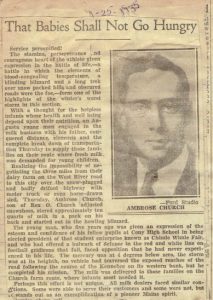 One of the most thoughtful gifts my son has ever given me is a small, black journal with blank pages which I carry with me every day. Kevin’s instructions to me at the time were to write down my memories as well as my family’s memories and stories. His good intentions became my inspiration and abiding interest, my focus in my family history research, and my obligation. Scribbling madly, I started asking for stories to preserve for our following generations.
One of the most thoughtful gifts my son has ever given me is a small, black journal with blank pages which I carry with me every day. Kevin’s instructions to me at the time were to write down my memories as well as my family’s memories and stories. His good intentions became my inspiration and abiding interest, my focus in my family history research, and my obligation. Scribbling madly, I started asking for stories to preserve for our following generations.
I soon understood that there is a significant difference between stories and memories. Memories are the foundation and basis for the stories they may become as time puts them in a different context. While some are skeletons in the making, our family stories give us a better understanding of our ancestors’ characters and their perspectives on their world, as well as some insight into their actions and motivations. Continue reading The little black book
Making the skeletons dance

In his 1930 novel Immaturity, George Bernard Shaw wrote, “If you cannot get rid of the family skeleton, you may as well make it dance.” Shaw had a point with that statement. While we can deny them, hide them, or ignore them, we can’t remove the family skeletons from their places in our family trees. Once they’re “out of the closet,” those dry bones will walk around; what we make of them is up to us.
Scott C. Steward’s recent reposting of his article Genealogical Complexities brought to my mind the dilemma of all family history: how much do we really want to know, and what responsibility do we have in dispensing that information? Continue reading Making the skeletons dance
Crawley root tea
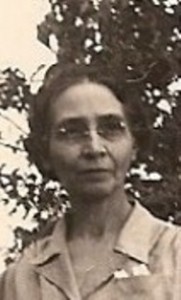
Whenever I, in another frenzy of research, dive into the bins of my family documents, artifacts, heirlooms, and memorabilia, I usually know what I’m looking for with little idea of what I’ll actually find, like my paternal grandmother’s herbal “recipes.” While there are more musicians in my family than medicine men or women, no one ever sang “A spoonful of sugar” to me as a child when I had to swallow my grandmother’s concoctions, decoctions, teas, infusions, tonics, and “prescriptions.” That I now remember crawley root tea in particular is evidence that it has indeed scarred me for life. Continue reading Crawley root tea
Bible studies
 One of the resources every family historian hopes to find and treasure is a family Bible full of handwritten notations of births, marriages, and deaths. These Bibles are often beautiful in themselves for their illuminated pages, or for the well-worn leather covers molded by devoted hands. Not to be overlooked, however, are the enclosures some owners pressed between those pages, enclosures which might yield some of the basic data always sought, and which might also give insight into the owners’ personalities and the events of their daily lives. Continue reading Bible studies
One of the resources every family historian hopes to find and treasure is a family Bible full of handwritten notations of births, marriages, and deaths. These Bibles are often beautiful in themselves for their illuminated pages, or for the well-worn leather covers molded by devoted hands. Not to be overlooked, however, are the enclosures some owners pressed between those pages, enclosures which might yield some of the basic data always sought, and which might also give insight into the owners’ personalities and the events of their daily lives. Continue reading Bible studies
A Victorian Christmas album
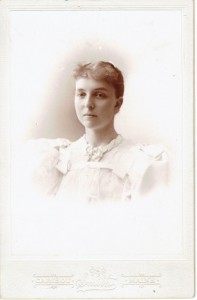
Searching for anything in My Old House carries certain risks, usually in the form of an interesting distraction (corsets, small bones I still refuse to discuss, or shoe lasts). My latest search turned up my maternal grandmother’s greeting card album, so I’ve completely forgotten what it was I initially sought! The album is a treasure of illustrated birthday and calling cards from friends and relatives, small “reward of merit” cards presented by her teachers, Valentine’s Day cards, Easter cards, and, of course, Christmas cards.
Lula Atlant Roberts McLeod (1876–1958) was a teacher in the schools of central Aroostook County, Maine, before her marriage in December 1899. Christmas cards had gained popularity from their beginnings in the 1850s, and by the 1890s, when my grandmother was teaching, cards with silk fringes were offered. She signed hers “Lula Roberts, Teacher.” Continue reading A Victorian Christmas album
The Red and White Schoolhouses
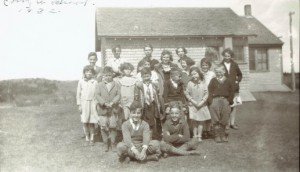
When I was perhaps three years old and lively, my mother returned to teaching grades K–8 in a one-room schoolhouse just north of our house in Augusta, Maine, known as the White Schoolhouse. Lacking daycare at the time, she took me with her most days, and I learned the Palmer method of cursive handwriting long before I learned to sit still. I didn’t realize until much later that the school had been a point of contention between my great-great-great-great-grandfather Read and the City’s school board. Continue reading The Red and White Schoolhouses